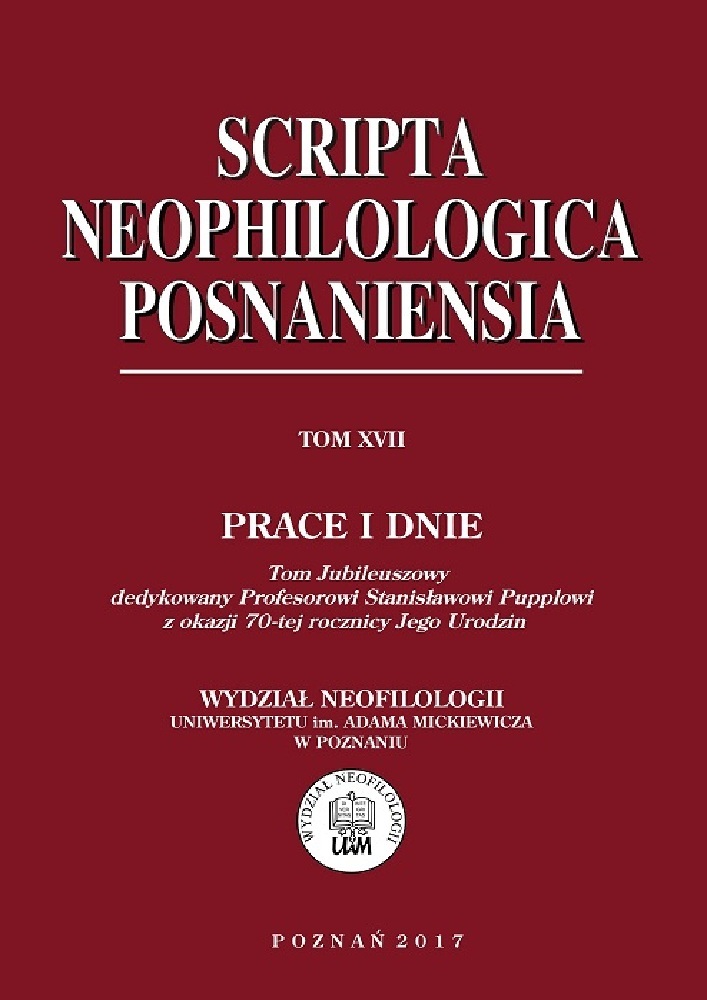Abstract
Uncovering the multidimensional identity of the human selfReferences
Barker, L.L. 1978. Communication. Englewood Cliffs, NJ: Prentice-Hall.
Barresi, J., and M. Raymond. 2011. “History as prologue: Western theories of the self”. In: Gallagher, Sh. (ed.). The Oxford handbook of the self. New York: Oxford University Press. 33–56.
Bois, J.S. 1966/1972. The art of awareness: a text on general semantics and epistemics. Second edition. Dubuque, IA: W.C. Brown.
Brentano, F. 1874. Psychologie vom empirischen Standpunkt. Leipzig: Duncker and Humblot.
Bühler, K. 1934/1990. Theory of language. The representational function of language. Trans. Donald Fraser Goodwin. Amsterdam, Philadelphia: John Benjamins (Foundations of Semiotics 25). [Sprachtheorie. Die Dastellungsfunktion der Sprache. Jena: Gustav Fischer.].
DeVito, J.A. 1976. The interpersonal communication book. New York, (etc.): Harper and Row.
Drever, M. 2013. Image, identity, and the forming of the Augustinian Soul. Oxford: Oxford University Press.
Erikson, E.H. 1959. Identity and the life cycle. Selected papers with a historical introduction by David Rapaport. New York: International University Press.
Erikson, E.H. 1968. Identity, youth, and crisis. New York: Norton.
Fraassen, B.C. van. 2005. “Transcendence of the ego (The non-existent knight)”. In: Strawson, G. (ed.). The Self? Malden, MA; Oxford, UK; Carlton, VIC: Blackwell Publishing. 87–110.
Freud, S. 1923/1960. The ego and the id. Trans. Joan Riviere. New York: W. W. Norton and Company, [Das Ich und das Es. Leipzig. Wien, Zürich: Internationaler Psychoanalytischer Verlag].
Gallagher, Sh. 2011. “Introduction: a diversity of selves”. In: Gallagher, Sh. (ed.). The Oxford Handbook of the Self. Oxford: Oxford University Press. 1–29.
Griskevicius, V. and D.T. Kenrick. 2013. “Fundamental motives: how evolutionary needs influence consumer behavior.” Journal of Consumer Psychology 23.3. 372–386.
Hewitt, J.P. 1989. Dilemmas of the American self. Philadelphia: Temple University Press.
Kehr, M. W. 1916. “The doctrine of the self in St. Augustie and in Descartes.” The Philosophical Review XXV.4. 587–615.
Kenrick, D.T., Neuberg, S.L. and R.B. Cialdini. 1999/2002. Social psychology. unraveling the mystery. Boston: Allyn and Bacon.
Korzybski, A. 1923/1995. Manhood of humanity. Lakeville, Conn. International Non-Aristotelian Library.
Korzybski, A. 1933/1994. Science and sanity. an introduction to non-Aristotelian systems and general semantics. New York: International Non-Aristotelian Library.
Lakoff, G., and M. Johnson. 1980. Metaphors we live by. Chicago, London: Chicago University Press.
Lakoff, G. 1984/1987. “Cognitive models and prototype theory”. In: Neisser, U. (ed.). Concepts and conceptual development. Ecological and intellectual factors in categorization. New York, Cambridge: Cambridge University Press. 63–100.
Lakoff, G. 1997. “The internal structure of the self”. In: Neisser, U. and D.A. Jopling (eds.). The conceptual self in context. Culture, experience, self-understanding. Cambridge: Cambridge University Press. 92–113.
Lakoff, G. 1987. Women, fire and dangerous things. What categories reveal about the mind. Chicago, London: Chicago University Press.
Langacker, R. 1990. Concept, image, and symbol: the cognitive basis of grammar. Berlin, New York, NY: Mouton de Gruyter.
Langacker, R. 1987/1999. Foundations of cognitive grammar. Vol. I. Theoretical prerequisites. Stanford, CA: Stanford University Press.
Lock, A. and K. Symes. 1996/1999. “Social relations, communication, and cognition”. In: Lock, A. and Ch.R. Peters. (eds.). Handbook of human symbolic evolution. Oxford, UK: Clarendon Press / New York, NY: Oxford University Press / Oxford, UK, and Malden, MA: Blackwell Publishers. 204–235.
Locke, J. 1960/1975. An essay concerning human understanding. Oxford, UK: Oxford University Press.
Maslow, A. H. 1943. “A theory of human motivation”. Psychological Review 50. 370–396.
Maslow, A. H. 1954/1970. Motivation and personality. New York: Harper and Row.
Neisser, U. 1997. “Concepts and self-concepts”. In: Neisser, U. and D.A. Jopling (eds.). The conceptual self in context. Culture, experience, self-understanding. Cambridge: Cambridge University Press. 3–12.
Neisser, U. 1988. “Five kinds of self-knowledge.” Philosophical Psychology 1. 35–59.
Neisser, U. 1967. Cognitive psychology. New York: Appleton-Century-Crofts.
Parfit, D. 2011. “The unimportance of identity”. In: Gallagher, Sh. (ed.). The Oxford Handbook of the Self. Oxford: Oxford University Press. 419–442.
Parfit, D. 2011. On what matters. Vol. I and II. Oxford: Oxford University Press.
Parfit, D. 1984. Reasons and persons. Oxford: Oxford University Press.
Peirce, Ch.S. 1902. “The simplest mathematics”. In: Hartshorne, Ch. and P. Weiss (eds.). Collected papers of Charles Sanders Peirce, vols. 1–6, 1931–1935; and In: Burks A.W. (ed.). vols. 7–8, 1958. Cambridge, MA: Harvard University Press. 227–323 (abbreviated as CP 4.227–323).
Rogers, C.R. 1951. Client-centered therapy. Its current practice, implications and theory. Boston: Houghton Mifflin.
Rogers, C.R. 1961. On becoming a person. A therapist’s view of psychotherapy. Boston: Houghton Mifflin.
Rolfe, L. 1996/1999. “Theoretical stages in the prehistory of grammar”. In: Lock, A. and Ch.R. Peters (eds.). Handbook of human symbolic evolution. Oxford, UK: Clarendon Press / New York, NY: Oxford University Press / Oxford, UK, and Malden, MA: Blackwell Publishers. 776–792.
Short, T.L. 1997. “Hypostatic abstraction in self-consciousness”. In: Brunning J. and P. Foster (eds.). The rule of reason: the philosophy of Charles Sanders Peirce. Toronto, Buffalo, London: University of Toronto Press.
Short, T.L. 2007. Peirce’s theory of signs. New York, Cambridge: Cambridge University Press.
Tajfel, H. and J.C. Turner. 1979/1986. “The social identity theory of inter-group behavior”. In: Worchel, S. and W.G. Austin (eds.). Psychology of intergroup relations. Chicago: Nelson-Hall. 7–24.
Țapu, C.Ș. 2001. Hypostatic personality: psychopathology of doing and being made. Ploiești: Editura Premier.
Taylor, Ch. 1999. Sources of the self: the making of the modern identity. Cambridge: Cambridge University Press.
